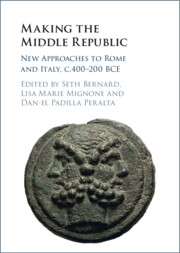Book contents
- Making the Middle Republic
- Making the Middle Republic
- Copyright page
- Contents
- Figures
- Tables
- Charts
- Contributors
- Acknowledgments
- Maps
- 1 Introduction
- Part I Historical Sources
- 2 Italian Descent in Middle Republican Roman Magistrates
- 3 The Long Shadow of Tributum in the Long Fourth Century
- 4 Paying for Conquest in the Early Middle Republic
- 5 Building up Slaveries in Ancient Italy and the Central Sudan
- Part II Material Sources
- Part III Architecture and Art
- Conclusion
- Bibliography
- Index
4 - Paying for Conquest in the Early Middle Republic
from Part I - Historical Sources
Published online by Cambridge University Press: 20 April 2023
- Making the Middle Republic
- Making the Middle Republic
- Copyright page
- Contents
- Figures
- Tables
- Charts
- Contributors
- Acknowledgments
- Maps
- 1 Introduction
- Part I Historical Sources
- 2 Italian Descent in Middle Republican Roman Magistrates
- 3 The Long Shadow of Tributum in the Long Fourth Century
- 4 Paying for Conquest in the Early Middle Republic
- 5 Building up Slaveries in Ancient Italy and the Central Sudan
- Part II Material Sources
- Part III Architecture and Art
- Conclusion
- Bibliography
- Index
Summary
In imposing citizenship on the defeated Latins and Campanians following the Latin War, the senate’s principal object was not, as is sometimes asserted, to increase the number of recruits available for the Republic’s legions. Its aim, rather, was financial. Lengthy campaigns in Samnium were in prospect. These would require substantial increases in annual outlays for stipendium and other costs well above what had been usual when warfare had entailed briefer operations mainly within Latium. Those increases would in turn require significantly more tributum to be collected from the Republic’s assidui. The senators consequently faced a choice: they could greatly increase the tributum paid by each of the old citizens, or they could dramatically enlarge increase the number of tributum payers by turning many of the recently defeated Latins and Campanians into new citizens optimo iure or sine suffragio and thereby impose a lighter financial burden on each. The senate’s choice to distribute the greatly increased cost of future wars among many more assidui to a very great extent underwrote the long series of lengthy campaigns in Samnium and elsewhere after 338 that would gradually and inevitably establish Rome’s dominion over the Italian Peninsula.
- Type
- Chapter
- Information
- Making the Middle RepublicNew Approaches to Rome and Italy, c.400-200 BCE, pp. 64 - 79Publisher: Cambridge University PressPrint publication year: 2023



